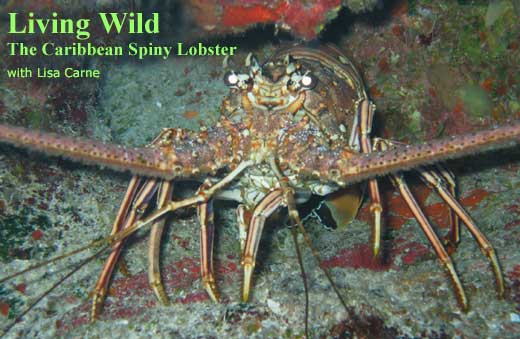The
Caribbean Spiny Lobster, Panulirus argus, Langosta
in Spanish,
Húgawaru in Garuifuna
There
is more than just one species of lobster in Belize. We
have the Caribbean Spiny lobster, the Spotted Spiny lobster
and three different Slipper lobsters.
The
Caribbean Spiny lobster, Panulinus argus, is by far the
most important species because of its relative abundance
and commercial importance. This lobster does not have
claws, but two very long antennae that often give away
their hiding spot. They have beady black eyes on the top
of their head and are locally called "bugs"
because of their appearance. And the name is appropriate
because they are in the same Phylum (Arthropoda) as all
insects! This lobster is not actually red underwater,
but more of a purple/rust color with tan and black markings.
Only when boiled does the lobster turn red.
The
Caribbean Spiny lobster takes 3-5 years to mature and
can reach a maximum length of two feet, although sometimes
they look a lot bigger underwater to the inexperienced
eye! Because they are nocturnal, they are usually hiding
under ledges or in crevices during the day, but tour guides
sometimes coax them out of hiding for a good view. They
can be found either snorkeling or diving as they range
from 3-130 feet deep.
Lobster
meat is of course, rich and delicious and they are heavily
fished. Many fishermen set traps on the shoals, baiting
them with cowhide and checking the traps every three-four
days. Alternatively, fishermen free-dive, that means without
the use of any SCUBA, to depths of 70 feet(20m) for these
valuable commodities. In Belize, lobsters are caught with
a hook-stick: a long stick with a large hook on the end.
The lobster is caught by sliding the stick under its soft
belly and rapidly jerking the hook up and out which is
not as easy as it sounds! The lobster is actually a fast
swimmer, and it swims backwards, so if you miss, it can
skate over the reef instantly to another hiding spot!



